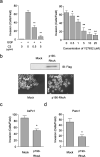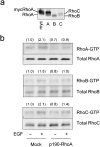Inactivation of Rho GTPases by p190 RhoGAP reduces human pancreatic cancer cell invasion and metastasis
- PMID: 16776779
- PMCID: PMC11158153
- DOI: 10.1111/j.1349-7006.2006.00242.x
Inactivation of Rho GTPases by p190 RhoGAP reduces human pancreatic cancer cell invasion and metastasis
Abstract
A number of small GTPases are involved in cancer cell proliferation, migration and invasion, acting as molecular switches that cycle between GTP- and GDP-bound states. GTPase-activating proteins (GAPs) have been established as a major class of negative regulators of Rho GTPase signaling. To investigate the biological function of p190 RhoGAP toward RhoA in cancer cell invasion and metastasis, we generated a chimera made of the RhoGAP domain of p190 and the C-terminus of RhoA (p190-RhoA chimera), and transfected it into human pancreatic cancer cells, AsPC-1. Epidermal growth factor (EGF)-induced activation of RhoA, as well as RhoB and RhoC, to a lesser extent, was significantly inhibited in p190-RhoA chimera-transfected AsPC-1 cells compared with that of control cells (mock-infected), when assessed by pull-down assay for GTP-bound RhoA, RhoB, and RhoC, respectively. EGF-induced invasion of p190-RhoA chimera transfectants was significantly inhibited compared with that of mock-infected cells in a modified Boyden chamber assay. Furthermore, the mice injected intrasplenically with AsPC-1 cells that overexpressed the p190-RhoA chimera had a marked reduction in the number and size of metastatic nodules in the liver. These data suggest that the inhibitory action of p190 RhoGAP toward RhoA offers a novel approach to the treatment of invasion and metastasis of cancer cells.
Figures




References
-
- Hall A. Rho GTPases and the actin cytoskeleton. Science 1998; 279: 509–14. - PubMed
-
- Etienne‐Manneville S, Hall A. Rho GTPases in cell biology. Nature 2002; 420: 692–35. - PubMed
-
- Olofsson B. Rho guanine dissociation inhibitors: pivotal molecules in cellular signalling. Cell Signal 1999; 11: 545–54. - PubMed
-
- Wang L, Yang L, Luo Y, Zheng Y. A novel strategy for specifically down‐regulating individual Rho GTPase activity in tumor cells. J Biol Chem 2003; 278: 44617–25. - PubMed
Publication types
MeSH terms
Substances
LinkOut - more resources
Full Text Sources
Medical
Molecular Biology Databases

